Nepal Tour with Tibet
Duration : 10 Nights / 11 Days
Destination : Kathmandu – Pokhara – Kathmandu – Lhasa – Kathmandu
Arrive at the international airport in Kathmandu. Meeting and assistance at the airport and transfer to hotel. Rest of the day at leisure. Overnight at hotel.
Day 02 : KathmanduBreakfast in the hotel. Later start a sightseeing tour of Kathmandu visiting Durbar Square and Swayambhunath.
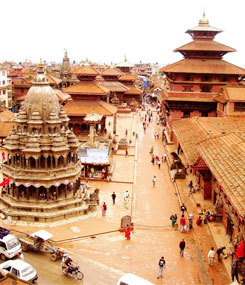
Kathmandu City
Kathmndu City : Kathmandu, the capital city of Nepal, is one of the world's oldest cities. It is also known as Kantipur. Here one can find distinctive pagoda-roofed temples, stone sculptures, old monasteries and histories monuments. Here you will visit the temple of the Living Goddess, who acknowledges the greetings of devotees from the balcony of here temple residence Kasthamandap – the source of the name Kathmandu and supposed to be made from the timber of a singe tree and Durbar Square are with it's array of temples overlooked by the Hanuman Dhoka Palace, the ancient place of the former Npealese Royalty.
Swayambhunath : Located approximately 4 km, Buddhist stupa this is said to be more than 2000 years old, making it one of the world's oldest and most glorious Buddhist chaityas. The Chaitya (stupa) which forms the main structure is composed of a solid hemisphere of brick and earth supporting a lofty conical spire capped by pinnacle of gilt copper. Painted on the four-sided base of the spire are the all-seeing eyes of lord Buddha. It stands on a hill which is a mosaic of small chaityas and pagoda temples.
In the late afternoon proceed for a tour of Patan city.
Patan : 5 km away from Kathmandu city, the ancient name of Patan is Lalitpur , meaning city of beauty and fine arts. It is enclosed within 4 stupas said to be built in 3rd century AD, by Emperor Ashoka. You will see the Durbar Square, the Patan Durbar which houses a bronze collection, the Krishna Temple built by King Siddhi Narsingh Malla, Hiranya Varna Mahavihar. The citiy is believed to have been built during the reign of Vira Dev in A.D. 299.
Overnight at hotel.
Early morning breakfast in the hotel, after breakfast drive to Pokhara (6.5 hrs drive approx.). Upon arrival in Pokhara check in at the hotel. Rest of the day at leisure/relax.
Pokhara : The rare combinations of snow clad peaks and snow fed lakes and rivers has helped to make the valley of Pokhara (210 km from Kathmandu) one of the most picturesque natural attractions in the kingdom. Pokhara Valley occupies a central location in Nepal and is dominated by the peaks of Annapurna range. A must for all visitors to Pokhara is the Phewa Lake. Its unique setting may be judged from the fact that the town of Pokhara (931 meters), is only fifty kilometers from Annapurna (8,091 meters) clearly seen from the valley on a clear day. Although Pokhara is a base for all trekkers to the Annapurna region, several mini treks can also be organized.
Overnight at hotel.
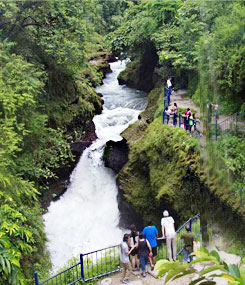
Davis Fall, Pokhara
Early morning, visit Sarangkot to view sunrise over the Himalayas (subject to weather conditions).
Return back to the hotel enroute visiting Bindyabasini temple. Reach hotel and have breakfast.
Later start a sightseeing tour of Pokhara visiting old part of Pokhara, Seti Gorge, Davis fall, Tibetan Refugee camp. In the late afternoon enjoy a boat ride on the beautiful Fewa Lake. Overnight at hotel.
Day 05 : Pokhara – Kathmandu (200 kms / 6.5 hours drive approx.)Breakfast in the hotel, later drive to Kathmandu.
Upon arrival in the city check in at the hotel. Rest of the day free for individual activities. Overnight at hotel.
(Days of operation for CA flight – Tuesday/Thursday/Saturday)
Breakfast in the hotel, later transfer to the airport to board the flight to Lhasa.
Upon arrival in Lhasa you will be transferred to the hotel. Rest of the day free to get acclimatize with the new weather.
Tibet : Up on the world's roof-top there lies a wide stretched land (Shangri-La as some people call it) filled with fascinating and mystifying works of nature and human that has captured the imagination of many great people ever since the world cam to know her existence. Tibet used to be mysterious, legendary and unknown Roof of the World, hidden and almost unreachable behind the highest mountains in the world can be easily reached today from Kathmandu, the capital city of Nepal to Lhasa either by road or air as well as from several cities from China.
Tibet is divided into three major region, the Central or Southern Tibet, Eastern and Western. Central/Southern Tibet is the most civilized and well developed where capital of Tibet, Lhasa is also located where resident of spiritual leader is located. Central Tibet is also a hub of cultural and main central of business center such as Shigatse, Gyantse, Tsedang and most popular destination of Everest Base Camp.
Eastern Tibet is forested, occupying approximately one-fourth of the land of Tibet. Virgin forest covers through the entire breath and length of this region, Kham and Amdo are the main attraction of Eastern Tibet and in this area is culturally consider very rich and prosperous as well. Wester Tibet is more remote and barren howeger some of the most sacred sites are located in this area including ancient civilization of Kingom of Guge.
Overnight at hotel.
Breakfast in the hotel. Later start a sightseeing tour visiting Jokhang Temple, Sera Monastery and Barkhor Market.
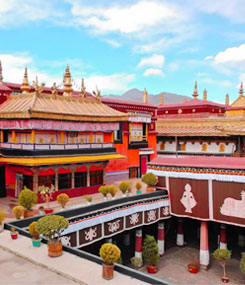
Jokhang Temple, Lhasa
Jokhang Temple : Formerly called the Trulnang Temple of Temple of "magical appearance' – erected by King Songtsen Gampo, 7th century – to house statute of Akshobhya Buddha – in Tibetan Jowo Miko Dorje – given to him by his Nepalese wife Princess Bhirikuti. Later statue of Jowo Shakyamuni given to him by his Chinese wilfe Princess Wen Cheng, was moved here from the Ramoche Temple that is present name became Jokhang, the "Shrine of the Jowo". It is one of the holiest of temples in Tibet and is the main centre of pilgrimage.
Barkhor Makret : The most popular Barkhor Market (Bazaar) is a square where Tibetan handicraft items, Buddhist artifacts, carpets, paintings etc. are all in sale for your delight.
Sera Monastery : The monastery is approx. 5 km drive away from Lhasa. Sera Monastsery was founded in1419. It sits in the prettiest and most charming atmosphere at the base of Mount Purbuchok. Sera Monastery used to be an important center fro learning where the past approx. 5,000 to 6,000 monks resided. Currently about 550 monks are supposed to be living there. The important structures inside the monastery include Coqen Hall (the main assembly hall), three Zhacangs (Buddhist colleges) and twenty-nine Khangtsens (monk dormitories). The most intriguing feature here is the nine-meter image of Maitraya which was erected in 1419; here one can also witness the practicing of debate among the monks, who pitch their knowledge against each other.
Overnight at hotel.
Breakfast in the hotel, this day we will take you to a sightseeing tour visiting Potala Palace and Drepung Monastery.
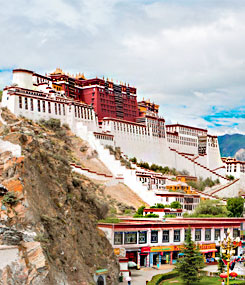
Potala Place, Lhasa
Potala Palace : Also known as the "winter palace" of Dalai Lama. The imposing structure of the palace dominates the landscape of Lhasa, is a 13th storied complex monument rising to a height of above 117m which houses 10,000 shrines and over 200,000 images and about 1000 rooms. As you are guided through the ancient chambers of the palace, you get to see Tibetan art at its best. The Potala Palace has a vast array of intricate Tibetan murals and beautiful statues. You will also get to view the Tombs of the eight Dalai Lamas.
Drepung Monastery : 8 km west of Lhasa, one of the three great Gelukpa Monasteries near Lhasa, the other two being Sera and Ganden. Until the occupation it served like its two sister monastesries as centre for learning and monastic training to which monks from all over Tibet would come to spend as long as 15 years methodically studying and debating the meaning of the Buddhis scriptures. For centuries it existed as a small monastic township housing throughs of fully ordained monks and other functionaries. It was founded in 1416 by Jamyang Choje Tashi Pelden, a disciple of Tsong Khapa.
Overnight at hotel.
Breakfast in the hotel, later proceed for an excursion trip to Namtso lake.
Namtso Lake : Today you will be taken on an excursion to one of the most beautiful places in Tibet, the Nam Tso Lake. In Tibetan, Nam Tso means 'Heavenly Lake', It is one among the three holy lakes in Tibet. Nam Tso lake is the highest (not the largest) saltwater lake in the world at an elevation of an altitude of 4718 m. It covers vast area of about 757 square miles. The crystal-clear water of this lake and the scenic beauty of its surrounding are sure to leave you spellbound. Drive back to the hotel. Overnight at hotel.
Day 10 : Lhasa – Kathmandu (CA 407 1155 (tibet time) /1110 (Kathmandu time))Breakfast in the hotel, later transfer to the airport to board the flight to Kathmandu. Upon arrival in Kathmandu check in at the hotel.
Afternoon a sightseeing tour of Pashupatinath and Boudhanath.
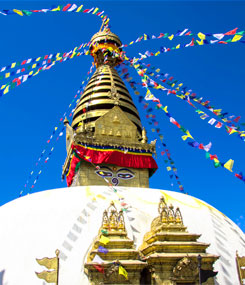
Boudhnath Stupa, Kathmandu
Pashupatinath : situated approx. 4 km east of Kathmandu city, is the holiest of all the Shiva shrines in Nepal and is the abode of Lord Pashupatinath, the guardian spirit of Nepal. It is situated amidst a lush green natural setting on the bank of Holy River Bagmati. Pashupati area is regarded as one of the most important places of pilgrimages for the followeres of Hinduism. Thousands of devotees from within and outside the country come to pay homage to Pashupatinath every day. And on special occasions like Ekadasi, Sankranti, Mahashivratri, Teej Akshaya, Rakshabandhan, Grahana (eclipse), Poornima (Full moon day) people congregate here in far greater number. Pashupati area is also included in the list of World Cultural Heritage.
Boudhanath : This colossal stupa, one of the biggest in the world of its kind, is situated approx. 8 km east of the Kathmandu city. It stands with four pairs of eyes in the four cardinal directions keeping watch for righteous behavior and human prosperity. This Buddhist stupa was built by King Man Deva at the advice of Goddess Mani Jogini. Built on a octagonal base, the stupa is surrounded with a wall inset with prayer wheels. It is common to see dozens of worshippers constantly circumambulating the stupa while taking care to spin each of the sacred prayer wheels. Around the stupa and in the surrounding fields are many Tibetan Buddhist monasteries.
Overnight at hotel.
In time transfer to the international airport to board the flight to onward destination.
*** Check-in and check-out time is 12.00 hrs ***
Our Services ends here…